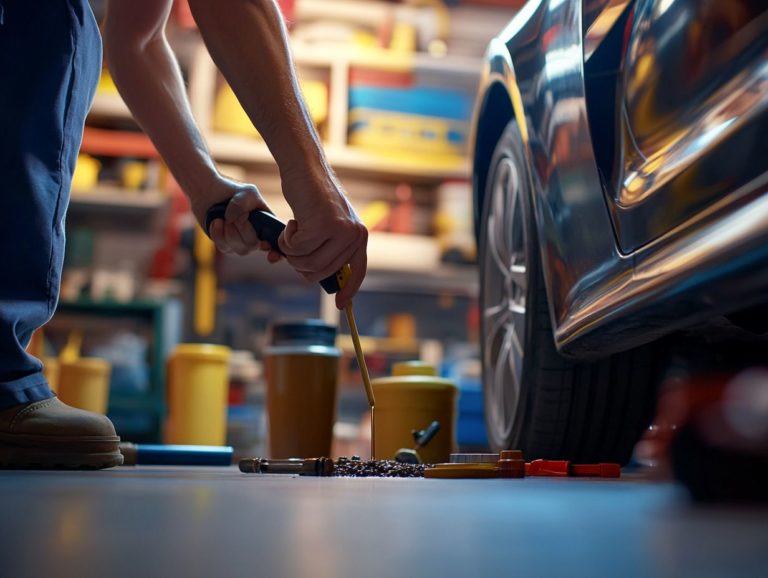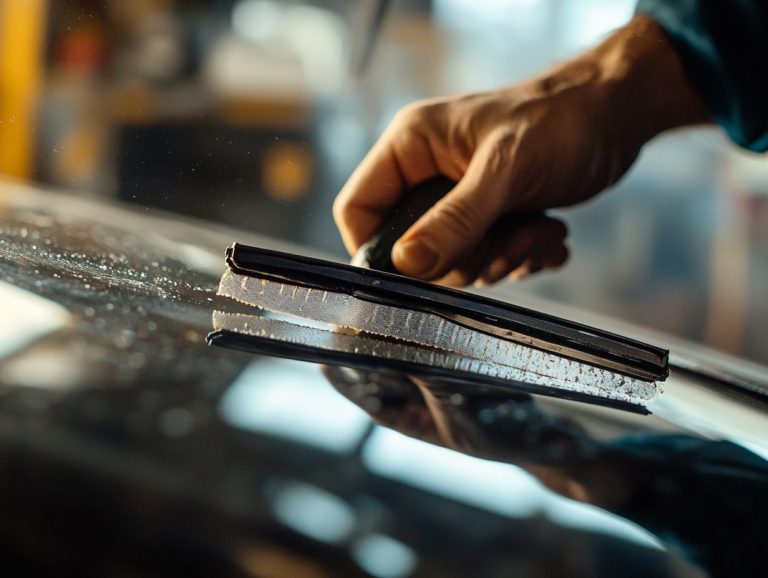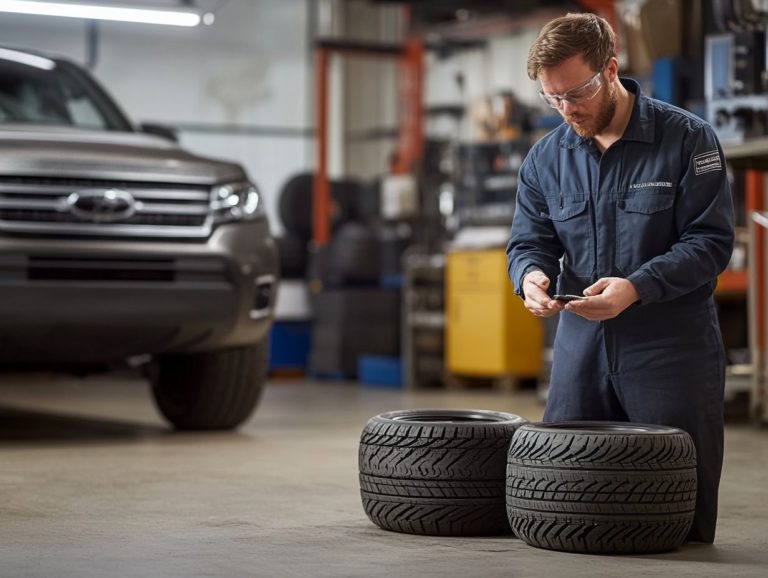What Should You Check Before a Long Drive?
Planning a long drive can evoke a sense of anticipation and a hint of trepidation. To ensure a seamless journey, it’s important that you prepare both your vehicle and yourself carefully.
From verifying fluid levels and tire pressure to ensuring that your lights and signals are in working order, every detail counts. Equally important is your personal preparation; getting adequate rest and mapping out your route are vital steps not to be overlooked.
Being equipped for emergencies can transform your road experience. This guide offers essential checks and tips for a safe and enjoyable ride.
Contents
Key Takeaways:

- Before embarking on a long drive, make sure to check your vehicle’s fluid levels, tire pressure, and lights and signals for proper functioning.
- In addition to preparing your vehicle, make sure you are well-rested and have a plan for your route and stops.
- Keep essential items in your car to be ready for emergencies and know what to do in case of an emergency. Also, practice safe driving techniques and avoid fatigue during long drives.
Preparing Your Vehicle for a Long Drive
Preparing your vehicle for a long drive is crucial for your safety and comfort throughout the journey. Begin with a thorough vehicle inspection that covers checking the tires, fluid levels, lights, brakes, and electrical systems.
By conducting visual inspections and performing necessary maintenance tasks, you enhance your vehicle’s performance while reducing the risk of breakdowns on the road. Don t forget to pack an emergency kit and ensure that all essential components are in working order this will help you enjoy a stress-free expedition.
With the right pre-trip checklist and a keen eye for detail, you can embark on your adventure with confidence.
Checking Fluid Levels and Tire Pressure
Checking fluid levels and tire pressure is an essential step in preparing your vehicle for a long drive, ensuring it runs like a dream. Investing a little time in inspecting and maintaining these components can make the difference between a comfortable journey and an inconvenient breakdown.
Regularly checking your oil level is crucial for keeping your engine running efficiently, warding off overheating and excessive wear. Similarly, keeping an eye on coolant levels (the liquid that helps keep your engine from overheating) is vital for maintaining your engine s optimal temperature, which is essential for both performance and longevity.
Ensuring the correct tire pressure boosts fuel efficiency and enhances handling and safety. To carry out these checks, you only need a few simple tools: a dipstick for the oil, a coolant gauge for the antifreeze levels, and a tire pressure gauge to assess psi.
Each of these straightforward tasks plays a significant role in ensuring a safe and enjoyable driving experience.
Ensuring Proper Function of Lights and Signals
Ensuring that your lights and signals function properly is critical for safe driving, especially during a long journey or when navigating the roads at night. Properly working headlights illuminate the path ahead, while tail lights and brake lights allow vehicles behind you to react in time. Turn signals are essential for conveying your intentions to other drivers, making it important to check their functionality regularly.
To conduct a thorough visual inspection, take a stroll around your vehicle, switching on each light one by one. This approach confirms that every light operates correctly and allows you to spot any dim or flickering bulbs that may need replacement.
By maintaining visibility through these checks, you enhance your personal safety and promote clearer communication on the road, significantly reducing the risk of accidents.
Personal Preparation for a Long Drive
Personal preparation is as essential as checking your vehicle before a long drive, significantly influencing your focus and energy levels.
Getting adequate rest before your journey puts you in the optimal driving mindset. This helps you tackle the road with confidence and reduces the risk of fatigue.
Thoughtful nutrition, including packing nutritious snacks, is vital for sustaining your energy and concentration throughout the trip. A well-structured trip plan enriches your experience and prepares you for unexpected challenges.
Getting Enough Rest and Nutrition

Getting enough rest and nutrition is crucial for maintaining your energy levels during a long drive, impacting your concentration and safety.
When fatigue creeps in, it can slow your reaction times, cloud your judgment, and even cause brief moments when you fall asleep for a second. These unsettling instances can lead to serious accidents on the road.
As a driver, it s essential to prioritize nutritious snacks that keep your energy levels steady and help you maintain focus. Opt for healthy choices such as:
- Nuts: Great for protein and healthy fats
- Trail mix: A mix of nuts, seeds, and dried fruit
- Yogurt: Provides protein and probiotics
- Fresh fruits: Hydrating and nutrient-rich
These options provide vital nutrients and sustained energy without the dreaded crash that sugary snacks often bring. Aim for 7-9 hours of quality sleep before a long journey to maximize alertness and minimize accident risks.
Planning for Route and Stops
Planning your route and stops is essential for a smooth and enjoyable long drive. This ensures you take timely breaks and refuel when needed.
A well-crafted itinerary shields you from unexpected delays and enhances your overall experience. By identifying potential fuel stations along your route, you can avoid the stress of running low on gas in remote areas. Finding rest areas allows you and your travel companions to stretch your legs, grab a bite, and recharge.
This thoughtful approach creates a relaxed atmosphere, making the journey just as rewarding as the destination itself. With clear stops in mind, you can navigate with greater confidence and peace of mind, fully embracing your travel adventure.
Be Ready for Anything on Your Long Drive!
Emergency preparedness is crucial for a safe and secure journey, helping you navigate unexpected situations with confidence. Equip your car with an emergency kit to improve your response during a breakdown or accident.
This kit should include essential tools, first-aid supplies for basic medical needs, and items tailored to your unique needs. Familiarizing yourself with steps during an emergency like contacting roadside assistance or safely exiting your vehicle can enhance your readiness for any challenges that arise during your travels.
Essential Items to Have in Your Car
Pack essential items in your car to tackle emergencies confidently. Being well-equipped can enhance your response in stressful situations.
Consider including a first aid kit to address minor injuries or stabilize conditions until help arrives. A reliable flashlight with extra batteries is invaluable for navigating in the dark or signaling for assistance. A multi-tool can serve various purposes fixing minor mechanical issues or preparing food if stranded.
Non-perishable snacks and bottled water are crucial for maintaining energy during unexpected delays. Warm blankets provide comfort during chilly times. Each of these items plays a pivotal role in thriving amid challenges, highlighting the importance of meticulous preparation.
Don t wait until it s too late; prepare your emergency kit today!
Knowing What to Do in Case of an Emergency
Knowing how to respond in an emergency during a long drive can significantly reduce panic and help maintain control.
When facing challenges like a flat tire or sudden engine trouble, having a clear set of steps in mind can make all the difference.
- If you get a flat tire, your first move should be to pull over safely to a well-lit area away from traffic and turn on your hazard lights.
- Take a moment to assess the situation. If necessary, contact roadside assistance for help. Prioritize your safety before attempting any repairs.
For engine issues, stay calm! It’s your best tool in handling these situations. Check for signs like smoke or unusual noises. A basic understanding of these issues enhances your safety and equips you to communicate effectively with professionals when needed.
Tips for a Safe and Smooth Long Drive

Implement effective strategies for a safe and enjoyable long drive to elevate your travel experience and reduce risks. Embrace proper driving techniques, like maintaining a consistent speed and following traffic rules. This ensures you remain in command at all times.
Manage fatigue by taking regular breaks and engaging in activities to enhance your overall driving efficiency. By being proactive and mindful of your driving habits, you can savor your journey while placing safety at the forefront.
Driving Techniques for Long Distances
Using the right driving techniques for long distances is essential for ensuring both safety and comfort on the road.
Adopt strategies like maintaining a consistent speed, using cruise control a feature that allows your car to maintain a steady speed without using your foot on the accelerator and scheduling regular breaks. These practices enhance your journey and play a crucial role in preventing fatigue.
Keeping a steady pace improves fuel efficiency and reduces the risk of sudden braking or acceleration, creating a safer environment for everyone. Take the time to stretch and re-energize; this not only refreshes your mind but also leads to a more enjoyable travel experience.
Staying Alert and Avoiding Fatigue
Staying alert and avoiding fatigue are key ingredients for safe driving on long trips as they directly impact your reaction times and decision-making skills.
To keep your attention sharp, take regular breaks ideally every couple of hours. This gives you that much-needed mental reset. Engaging in stimulating conversations with passengers can enhance your focus and break the monotony. Don t underestimate the power of a lively podcast or some upbeat music; these can work wonders to keep your mind engaged.
Be mindful of physical and mental signs of fatigue, such as difficulty concentrating or constant yawning. Recognizing when to pause and rest could make the difference between a safe journey and a risky one, underscoring the importance of listening to your body s signals.
Frequently Asked Questions
What should you check before a long drive?
Before embarking on a long drive, check the following:
- Fluid levels (oil, coolant, brake fluid, windshield washer fluid)
- Tire pressure and tread depth
- Brake pads and rotors
- Headlights, taillights, and turn signals
- Wipers and windshield condition
- Spare tire and tire changing equipment
Why is it important to check fluid levels before a long drive?

Fluid levels are crucial for your car’s engine, brakes, and other systems. Low fluid levels can lead to mechanical failures and potentially leave you stranded on your long drive.
In conclusion, being prepared for a long drive and ensuring safety is essential. Always check your vehicle before hitting the road and stay alert to enhance your travel experience.
Have your own tips or stories related to long drives? Share them with us!
How often should you check tire pressure and tread depth?
Check your tire pressure and tread depth at least once a month. Before a long drive, it’s crucial to ensure these are in top shape for your safety.
What should you do if your brake pads are worn before a long drive?
Replace worn brake pads before hitting the road. Driving with them can reduce your stopping ability and increase the risk of accidents.
Should you check your headlights and other lights before a long drive?
Absolutely! Checking your car’s lights is vital for safety. A non-functioning light can also lead to a ticket.
Do you need to check your windshield before a long drive?
Yes! Inspect your windshield for cracks or chips. Small issues can grow and compromise its strength, making it more likely to shatter during an accident.






